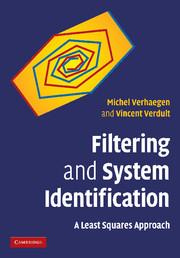Book contents
- Frontmatter
- Contents
- Preface
- Notation and symbols
- List of abbreviations
- 1 Introduction
- 2 Linear algebra
- 3 Discrete-time signals and systems
- 4 Random variables and signals
- 5 Kalman filtering
- 6 Estimation of spectra and frequency-response functions
- 7 Output-error parametric model estimation
- 8 Prediction-error parametric model estimation
- 9 Subspace model identification
- 10 The system-identification cycle
- References
- Index
7 - Output-error parametric model estimation
Published online by Cambridge University Press: 14 January 2010
- Frontmatter
- Contents
- Preface
- Notation and symbols
- List of abbreviations
- 1 Introduction
- 2 Linear algebra
- 3 Discrete-time signals and systems
- 4 Random variables and signals
- 5 Kalman filtering
- 6 Estimation of spectra and frequency-response functions
- 7 Output-error parametric model estimation
- 8 Prediction-error parametric model estimation
- 9 Subspace model identification
- 10 The system-identification cycle
- References
- Index
Summary
After studying this chapter you will be able to
describe the output-error model-estimation problem;
parameterize the system matrices of a MIMO LTI state-space model of fixed and known order such that all stable models of that order are presented;
formulate the estimation of the parameters of a given system parameterization as a nonlinear optimization problem;
numerically solve a nonlinear optimization problem using gradient-type algorithms;
evaluate the accuracy of the obtained parameter estimates via their asymptotic variance under the assumption that the signal-generating system belongs to the class of parameterized state-space models; and
describe two ways for dealing with a nonwhite noise acting on the output of an LTI system when estimating its parameters.
Introduction
After the treatment of the Kalman filter in Chapter 5 and the estimation of the frequency-response function (FRF) in Chapter 6, we move another step forward in our exploration of how to retrieve information about linear time-invariant (LTI) systems from input and output measurements. The step forward is taken by analyzing how we can estimate (part of) the system matrices of the signal-generating model from acquired input and output data. We first tackle this problem as a complicated estimation problem by attempting to estimate both the state vector and the system matrices. Later on, in Chapter 9, we outline the so-called subspace identification methods that solve such problems by means of linear least-squares problems.
Nonparametric models such as the FRF could also be obtained via the simple least-squares method or the computationally more attractive fast Fourier transform.
- Type
- Chapter
- Information
- Filtering and System IdentificationA Least Squares Approach, pp. 207 - 253Publisher: Cambridge University PressPrint publication year: 2007
- 1
- Cited by



